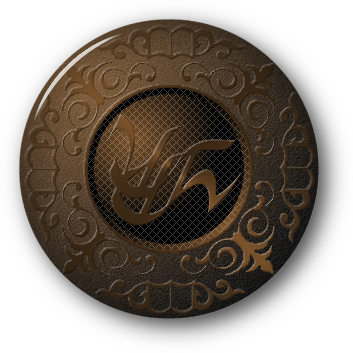

|
|
The Arabic Number System: Base 10 The D'ni number system is very different from the one we're used to. In our Arabic system, we can count up from zero to nine with single digits. To count higher than nine, we need two digits. The digit in the tens place tells us how many times we've cycled zero through nine, that is how many times ten is in the number, while the digit in the units place tells us where we are in the current cycle of zero through nine. Once we've hit ninety-nine, to count higher, we need a third digit for hundreds; then a fourth for thousands; and so on. This number system that we're used to is called base 10 — that is, each place in a number is ten times larger than the previous one. The tens place is ten times bigger than the units (10 = 10 x 1), the hundreds place ten times bigger than the tens (100 = 10 x 10), the thousands place ten times bigger than the hundreds (1000 = 100 x 10), and so on. For a practical example, let's look at the number 9017.
We see that each place is ten times larger than the previous one. The digit that is in each place tells us how many times that place occurs in the number: there are 9 thousands, 0 hundreds, 1 ten, and 7 units. When we multiply out (as in the diagram) and then add together, we get the number itself: 9000 + 000 + 10 + 7 = 9017. The D'ni Number System: Base 25 Unlike our Arabic system, D'ni uses a base 25 numbering system. This means that each place in a number is not ten but twenty-five times bigger than the previous one. To illustrate like we did with Arabic numbers, we start with 1 , 1. If we increase the number so that it requires two digits, 10 (0 is the D'ni number for zero), this new number is not equal to 10, as we would think within the Arabic system; the newly introduced place is twenty-five times bigger than the previous one, 25 x 1 = 25. Thus, the D'ni number 10 is equal to 25 in Arabic terms. Introduce a third place, 100 , and it's twenty-five times bigger than the second, twenty-fives place: 25 x 25 = 625. Introduce a fourth, 1000 , and it's twenty-five times bigger yet again: 625 x 25 = 15,625. And so on. Since D'ni is base 25, that must also mean that there are twenty-five basic digits to work with, the same way there are ten basic digits (0 through 9) in base 10. These D'ni digits are:
Let's look at a practical example, like the one above:
We now see that in D'ni, each place is not ten but twenty-five times larger than the previous one. As with Arabic numbers, the digit in each place tells us how many times that place occurs in the number: there are 9 fifteen-six-twenty-fives, 0 six-twenty-fives, 1 twenty-five, and 7 units. If we multiply out and add together as we did before, we get the value (in Arabic terms) of this D'ni number: 140,625 + 0000 + 25 + 7 = 140,657. In transliteration, we usually represent these D'ni numbers between square brackets, with each digit separated by a vertical bar: [9 | 0 | 1 | 7]. D'ni Numerals In English, every number can be written out with words; so too in D'ni, in a pattern that closely mirrors the logic that underlies the number system. The numbers 0 through 4 are all simple words:
Multiples of five are also simple words:
To fill in the numbers in between, we abbreviate the word for the closest but not exceeding multiple and combine it with the word for one through four. Thus, the number six ( 6 ) breaks down into the closest multiple of five, five, plus one, vat plus fa: vagafa (vagafa). (The ga means and, thus the word literally means five-and-one.) Similarly, the number fourteen ( $ ) breaks down into the closest multiple of five — ten — plus four, nAvU plus tor: nAgator (nāgator); and twenty-two ( \ ) is twenty plus two, riS plus brE: rigabrE (rigabrē). This is a table of the D'ni numbers from 1 through | for quick reference. (| is an alternative way of writing 10 , 25, when the number carries a special significance or stands alone, not part of a mathematical statement.)
D'ni Numbers Larger Than 24 When we write numbers larger than nine in English, we indicate the place of each digit in words: four thousand eight hundred and ninety three. In similar fashion, D'ni uses suffixes to indicate a digit's place. These suffixes are:
Thus, the D'ni number for twenty-five ( 10 ) is a fa (fa) in the twenty-fives place: fasE (fasē). Three hundred twenty-five ( #0 ) is a nAgasen (nāgasen) in the twenty-fives place: nAgasensE (nāgasensē). We can also write out numbers with digits in both places — one hundred twenty-one ( 4] ) is a tor (tor) in the twenty-fives place and a rigafa (rigafa) in the singles place: torsE rigafa (torsē rigafa). |
Myst, the Myst logo, and all games and books in the Myst series are registered trademarks and copyrights of Cyan Worlds, Inc. Myst Online: Uru Live is the sole property of Cyan Worlds Inc. The concepts, settings, characters, art, and situations of the Myst series of games and books are copyright Cyan Worlds, Inc. with all rights reserved. I make no claims to any such rights or to the intellectual properties of Cyan Worlds; nor do I intend to profit financially from their work. This web site is a fan work, and is meant solely for the amusement of myself and other fans of the Myst series of games and books. |

